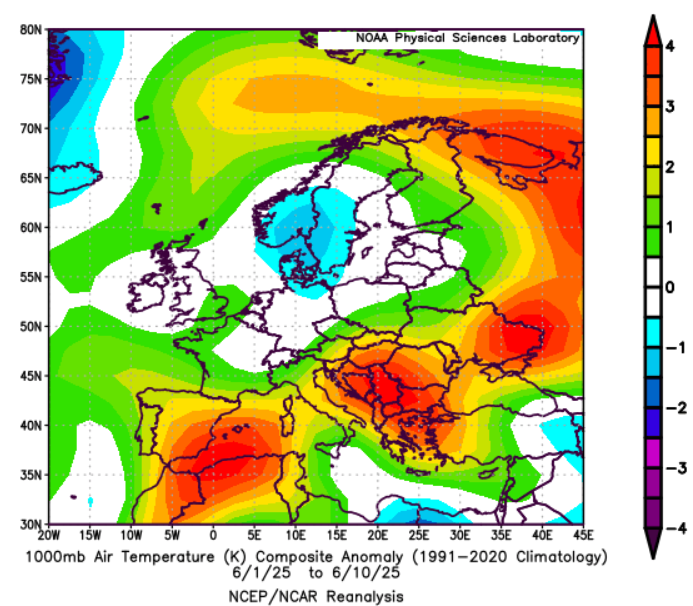
he first ten days of June 2025 reveal significant temperature anomalies across Europe, with three regions standing out due to their unusually warm conditions: Eastern Ukraine, the Balkans, and Southern Iberia. These anomalies, measured against the 1991–2020 climate baseline, signal an early surge in heat that could have notable impacts on local environments and communities.
Eastern Ukraine: Noticeable Warmth with Growing Implications
Eastern Ukraine experiences elevated temperature anomalies, reaching up to +3.5°C above average. This warming is substantial enough to mark a clear departure from typical early June conditions. The higher temperatures can accelerate evaporation rates, potentially stressing soil moisture levels and crops. This early heat surge also raises concerns for increased energy demand and heightened risks of heat-related health issues.
The Balkans: A Hotspot of Early Summer Heat
The Balkans region emerges as one of the warmest hotspots in early June 2025, with maximum temperature anomalies up to +4.0°C. Countries such as Serbia, Bulgaria, and northern Greece bear the brunt of this heat wave-like pattern. This elevated warmth signals an early onset of summer-like conditions, which could exacerbate drought risk, strain water resources, and intensify heat stress for populations and ecosystems alike.
Southern Iberia: Mild but Meaningful Warmth
Southern Iberia, including southern Spain and Portugal, records more moderate but still meaningful temperature anomalies, up to +3.0°C above average. While less extreme than Eastern Ukraine and the Balkans, this warming trend is notable for the region, which often grapples with water scarcity. The warmer-than-usual temperatures may worsen existing drought conditions and impact agriculture and water availability.
Atmospheric Drivers Behind the Heat
- Southern Iberia and the Balkans:
The heat anomalies in these regions are largely driven by the combined influence of the Sahara and the Azores High pressure system. The Saharan heat dome often pushes hot, dry air northward into southern Europe, while the Azores High anchors stable, sinking air over the Iberian Peninsula and parts of the Mediterranean. This pattern suppresses cloud formation, increases solar radiation, and amplifies surface heating.
The intense warmth in Eastern Ukraine is influenced by heat advection from Central Asia’s high-pressure systems. This circulation funnels warm continental air westward, leading to reduced cloudiness and increased surface temperatures in Eastern Europe. The persistent high-pressure conditions create a favorable environment for heat accumulation during early June.
Conclusion
The early June 2025 temperature anomalies highlight a pattern of significant warming across key European regions. The Balkans stand out with the highest maximum anomalies, approaching +4.0°C, followed closely by Eastern Ukraine with up to +3.5°C. Meanwhile, Southern Iberia experiences milder yet still impactful warmth. These early heat signals warrant attention as they may influence seasonal weather patterns, agricultural productivity, and public health challenges as summer progresses.

Source: https://psl.noaa.gov/data/composites/day/

Detail.


























